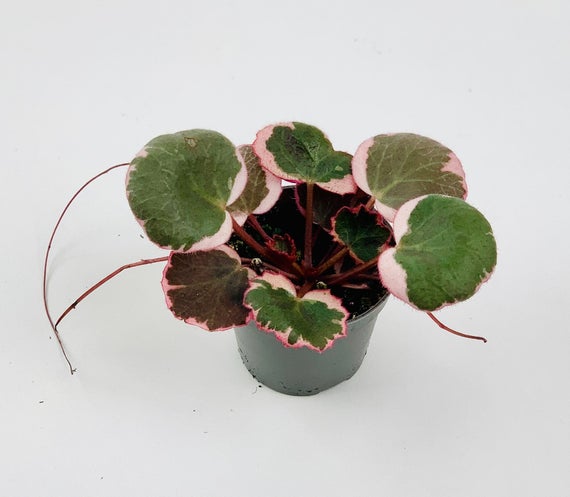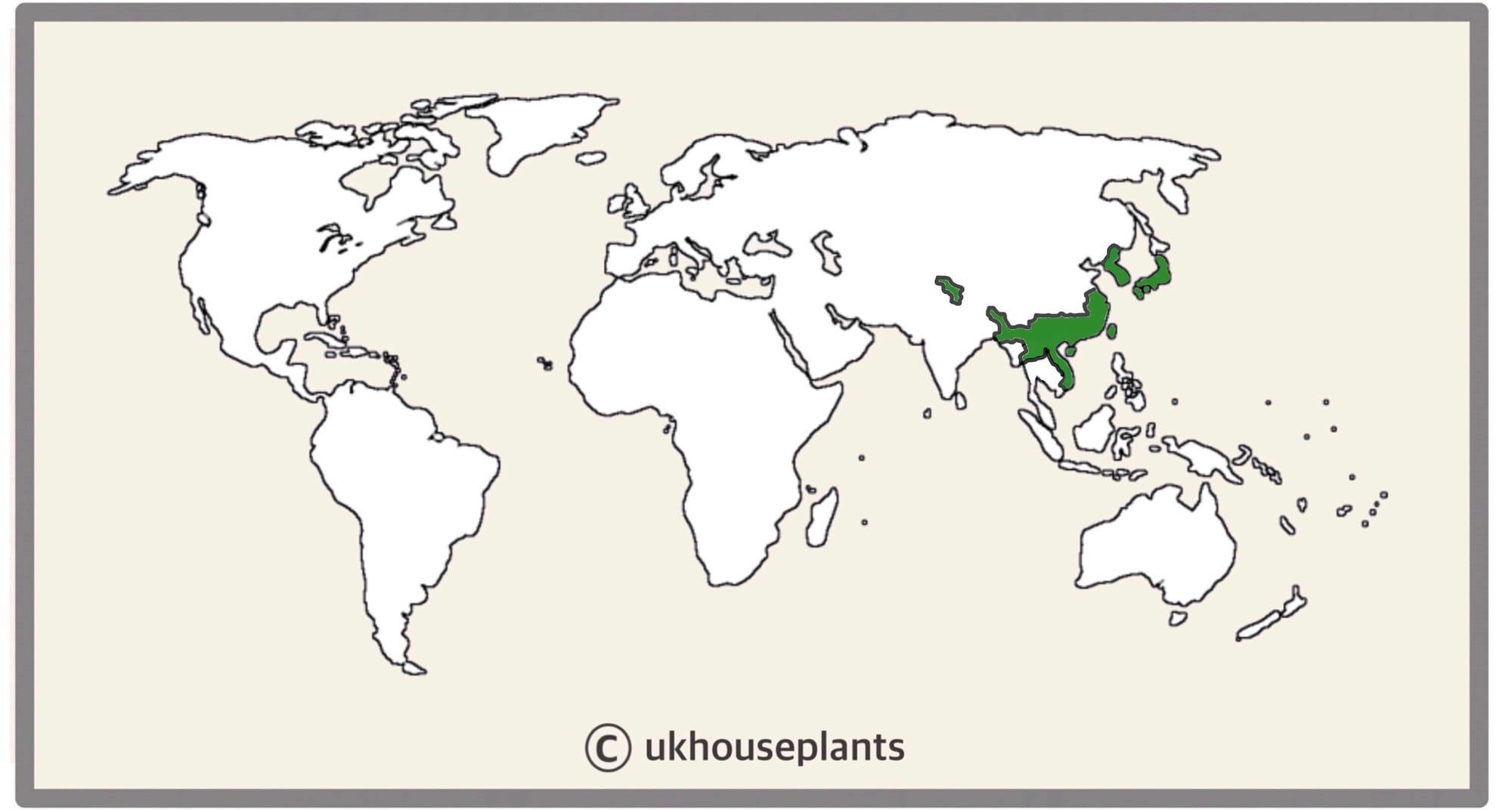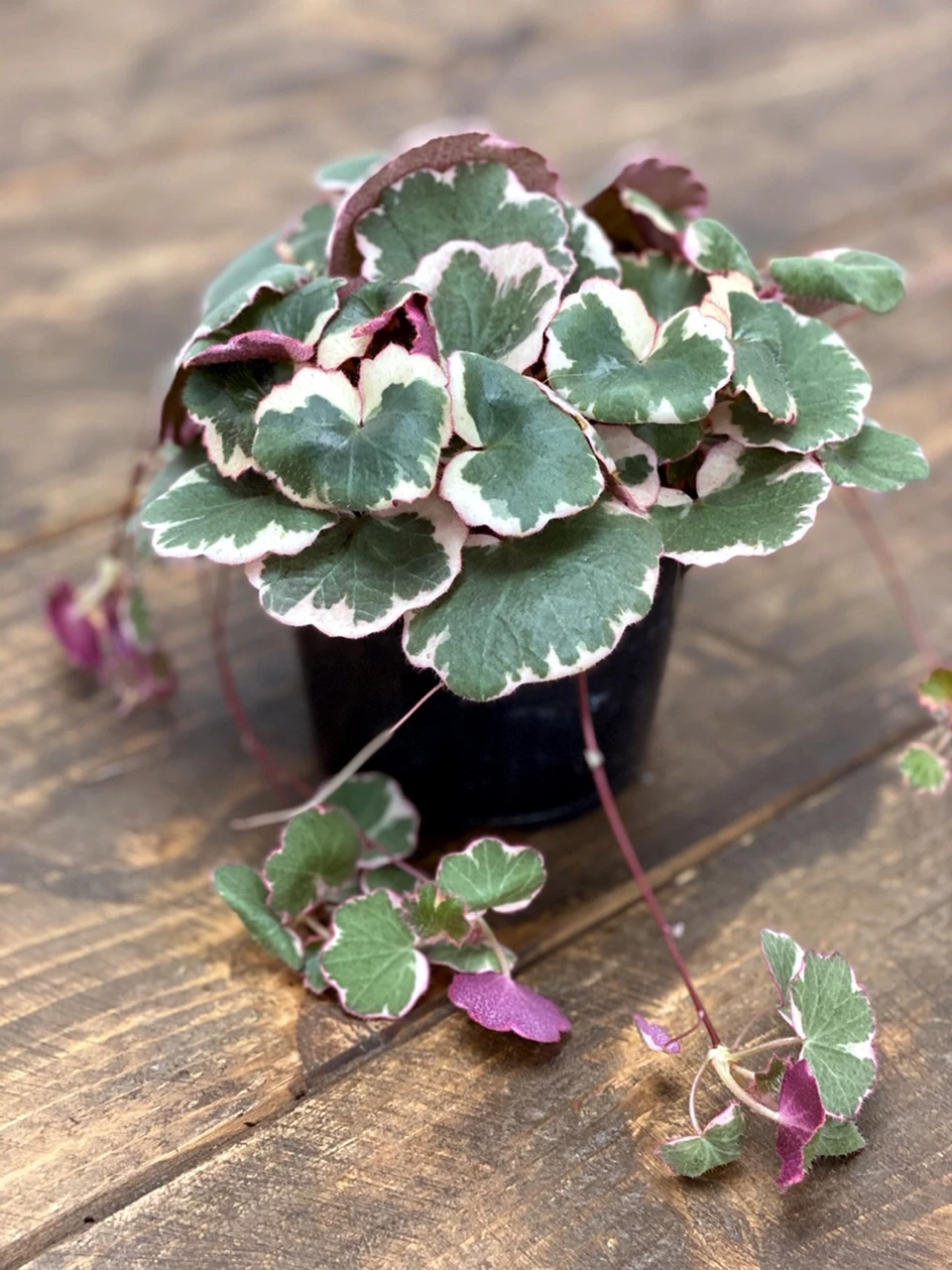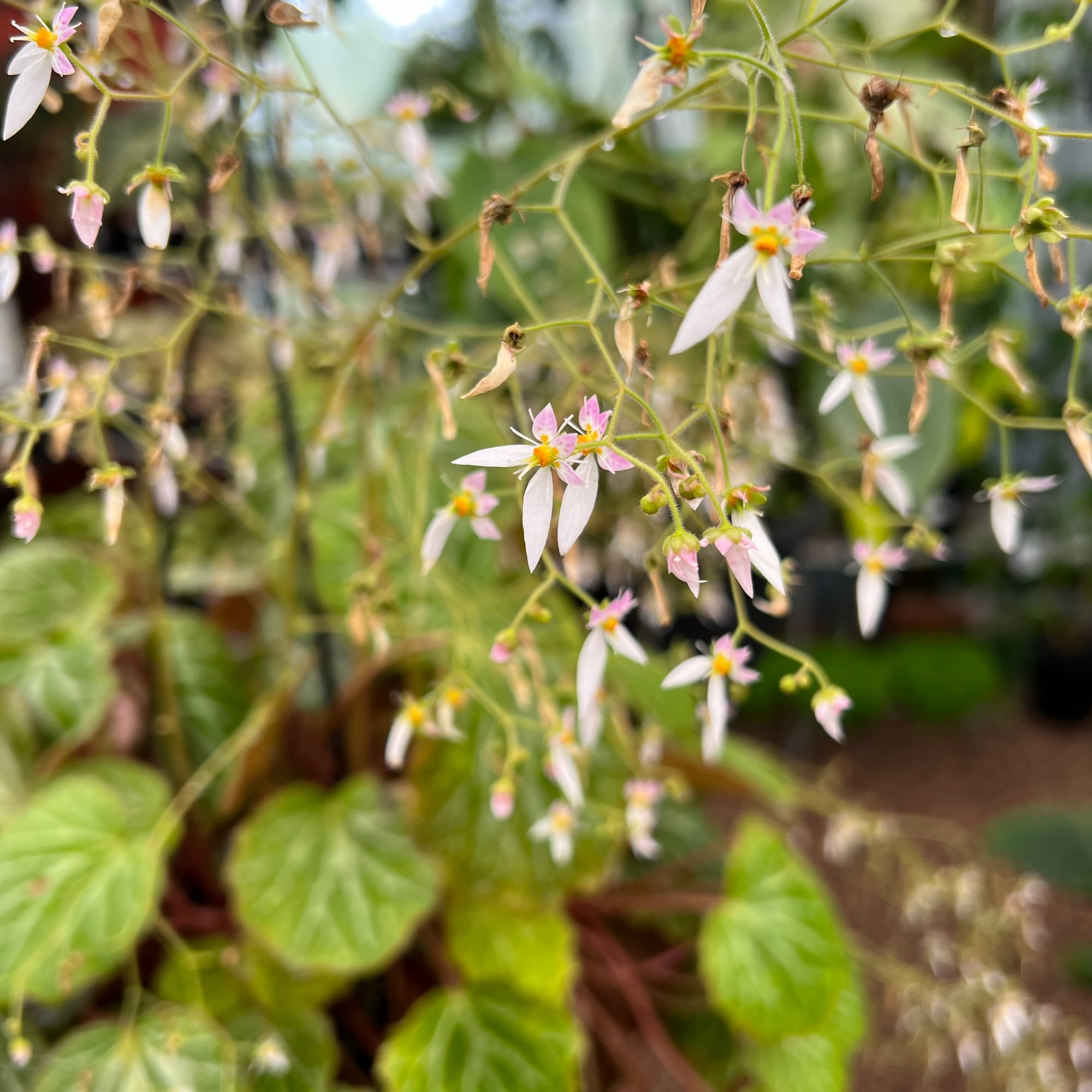
Saxifraga stolonifera ‘Tricolor’. Copyright: Crocus.co.uk.
Contents
- Top Tips
- Location, Water, Humidity & Fertilisation
- Common Issues
- Origins, Temperature, Propagation, Repotting & Toxicity.
Need the answer to a specific plant query? Book a 1-to-1 video call with Joe Bagley, the website's friendly author, to overcome and address your niggling problem! Available on iMessage, WhatsApp, Facebook Messenger & more.
Top Tips & Info
- Care Difficulty - Easy to Moderate
- Strawberry Begonia will require a bright, indirect location with regular waters. Periods of drought will significantly increase the risk of leaf loss and crisping foliage, so it's important to keep an eye out for dry soil.
- We'd recommend situating yours in a north-facing window or under a grow-light for optimum growth.
- Avoid under-watering as the risk of dehydration during the spring and summer months is relatively high. Over-watering, however, is less common but can still cause severe consequences to the specimen's overall health, like basal rot and death.
- Fertilise using a 'Houseplant' labelled feed every four waters in the spring and summer, reducing this to every six in the colder months.
- Repot every three or four years, during the spring, with a 'Houseplant' labelled potting mix and the next sized pot. Treat the roots with respect as Transplant Shock is a prominent killer among newly-repotted specimens.
- Keep an eye out for Mealybugs that'll hide in the plant's cubbyholes and under-leaves for the first two months of ownership.
- Scroll down to 'Propagation' to learn more about how to take 'plantlet' cuttings. The scientific name for this is a 'Stolon' cutting, which is very similar to the Spider Plant.
- The Strawberry Begonia isn't actually part of the Begonia family! It forms part of the Saxifraga family that includes Crassula (Jade Plants), Heuchera & Astilbes! (Both a popular outdoor plants in Europe).
Location & Light - 🔸🔸🔸
Your Strawberry Begonia is best kept in the brightest location possible, without the absolute risk of direct sunlight. This species loves overhead lighting, so be sure to sit yours on a north or east-facing windowsill for balanced, healthy growth. If you're interested in keeping it further away from the window, make sure that the foliage is penetrated by the natural light to avoid over-watering or weakened health.
Water - 🔸🔸🔸
Maintain evenly moist soil, allowing the top third to dry out in between waters. During the spring and summer, be sure to avoid under-watering too often, due to the risk of crisping foliage and stunted growth. Other under-watering symptoms include stolon death (baby plantlets) & browned areas forming on the leaf edges. These issues are usually caused by too much light/heat or just forgetfulness - remember, the brighter the location, the more watering you'll need to do. Over-watering symptoms include the central foliage beginning to yellow rot, little to no new growth, yellowing lower leaves and eventual plant death. If you feel that over-watering is to blame for its demise, click here to learn more about root rot and how to address it!
Humidity - 🔸🔸🔸
Although Strawberry Begonia can deal with average room humidity in the home, creating a humidity tray will not only provide a moist and stable environment for your plant, it'll downplay the risks of dehydration, too. This method is particularly good for those who regularly dehydrate their specimens, especially when located within a few metres of an operating heater.
Fertilisation - 🔸🔸
Fertilise every four waters during the growing period before reducing this to every six in the autumn & winter. Although an 'All-Purpose' fertiliser will still do the job, we'd recommend using a specific 'Houseplant' labelled fertiliser as it'll support the vital thirteen nutrients that this species will need to grow.
Common Issues with Strawberry Begonia
Yellowing lower leaves could be a sign of irrigation abuse, but equally is a byproduct of maturity. If the older leaves rapidly become yellow in quick succession, both under, or over-watering could be to blame. People don't realise that a plant's root system needs access to oxygen too; when soil is watered, the air will travel upwards and out of the potting mix. A lack of accessible oxygen for the roots will cause them to subsequently breakdown over the oncoming days. If yours is a victim of neglect, create a watering schedule to avoid forgetfulness in the future.
Crisped foliage with brown leaf-edges is the result of too little water and potential over-exposure to the sun. Strawberry Begonia are best located in bright settings, with those that haven't acclimatised to the harsh rays may show signs of sun-scorch and environmental shock. A splash of morning sunlight is acceptable as long as the soil moisture is regularly observed, once the introductory period has elapsed.
If your specimen is located in a dark environment with mould developing on the compost's top layer, use a chopstick to gently stab the soil in various areas. Aim to enter the compost between the base of the plant and the pot's edge, as failure to do so may lead to damaging its lower portion. Leave the holes open for a few days before re-surfacing the soil to avoid it becoming overly dry. Not only will the gentle shift in the soil's structure mimic the work of small invertebrates in the wild (worms, etc.), but it'll also add oxygen back into the soil, thus reducing the risk of root rot. Repeat this monthly, or whenever you feel the potting-mix isn't drying out quickly enough.
Mealybugs are white shell-like critters that'll slowly extract the sap from of its leaves. Have a check under the foliage, most notably along the midrib, for cottony webs and the critters. Click here to read our article about the eradicating Mealybugs, along with some extra tips that you may not find elsewhere!
Failed plantlet-cuttings could be the product of several different reasons. As Strawberry Begonia are best propagated during the spring, those taken in the dormant months will root much slower, and could even die in the meantime. Study the cutting's environment - is there enough light to read a newspaper? If not, improve the growing conditions by increasing the amount of indirect sunlight it receives. Never situate it in direct sunlight too, as this will result in severe dehydration nd most likely death. The overall size of the cutting will play a big part in its success, with those that are at least the size of the planet's pictured in Image 1, being most likely to root. Smaller specimens won't root appropriately due to the lower amounts of stored energy situated in the leaf, so the overall size is always a key element to master. As the leaves should be propagated via hydroponics (in water), replace the water weekly to prevent the bacteria's risk of thriving within the container. Keep the foliage mostly above the waterline, as yellow or browned sections that slowly rot away is caused by poor hygiene or over-submersion that'll lead to suffocation. Scroll down to 'Propagation' for more information on plantlet-cuttings!
 You may notice thin red tendrils developing from the base of your plant. This is completely normal for a maturing specimen, where it's reaching out for support to develop more stable growth.
You may notice thin red tendrils developing from the base of your plant. This is completely normal for a maturing specimen, where it's reaching out for support to develop more stable growth.
Origins
William Curtis first documented the species in 1774, placing it in the genus that Carl Linnaeus first erected. The term, Saxifrage, was first penned in the early 1700s by Joseph Pitton de Tournefort, who used the Latin term of 'rock dwelling' to describe its ecology. The specific epithet, 'stolonifera', refers to the species' ability to produce offsets along a short shaft that can be grown on as separate plants when mature.
 The Distribution of Saxifraga stolonifera
The Distribution of Saxifraga stolonifera
Temperature
8° - 32℃ (54° - 90℉)
H1c (Hardiness Zone 10 - 12) - Can be grown outdoors during the summer in a sheltered location with temperatures above 10℃ (50℉), but is fine to remain indoors, too. If you decide to bring this plant outdoors, don't allow it to endure any direct sunlight as it may result in sun-scorch and dehydration. Regularly keep an eye out for pests, especially when re-introducing it back indoors.
Spread
In a domestic setting, the overall length will up to 0.25m (0.8ft) in length, and the width of the pot.
Pruning & Maintenance
Remove yellow or dying leaves, and plant debris to encourage better-growing conditions. While pruning, always use clean scissors or shears to reduce the chance of bacterial and fungal diseases. Never cut through yellowed tissue as this may cause further damage in the likes of diseases or bacterial infections. Remember to make clean incisions as too-damaged wounds may shock the plant, causing weakened growth and a decline in health.
 Here is an excellent example of a 'plantlet' cutting that is now ready to be rooted in water! Copyright: Pinterest
Here is an excellent example of a 'plantlet' cutting that is now ready to be rooted in water! Copyright: Pinterest
Propagation
Via Seed, Plantlet Cuttings & Basal Offset Division.
Plantlet Cuttings (Stolons) (Easy) - As the size of the cuttings will greatly dictate their success, be sure to allow them to grow at least five mature leaves, as seen in the image above. To propagate, prune off the stem around 2cm (1 inch) from the base of the plantlet. Place its base into room temperature water, keeping the foliage mostly above the water to avoid them rotting. Thin white roots will develop quickly from its base (similar to Pilea cuttings), readying itself for soil transplantation in a matter of weeks. Once the plantlet has 5cm of root growth, place its bottom half in a 'Houseplant' labelled potting mix, making sure the leaves are entirely above the soil line. Provide a bright, indirect setting with continuous moist soil for best results. Treat it like a mature specimen, following the care tips provided at the start of this article. If you're experiencing issues with your cuttings, scroll up to the final paragraph in 'Common Issues' for more information!
Basal Offset Division (Easy to Moderate) - The best time to divide is during the repotting period in the spring or summer. To prevent transplant shock (common with heavy-handed transplants), water the plant 24hrs before the main event. Gently tease away some of the soil, and split the horizontal rhizome along with its healthy root systems. Do not touch, or over-finger the roots as the small hairs are sensitive and may cause death in some instances. Place the rhizome's base slightly submerged into moist 'Houseplant' compost, while avoiding submerging the leaves due to the risk of rot. Avoid direct sunlight or periods of droughts for best results.
Flowers
Domestically grown specimens may take a few years to bloom due to the insufficient growing conditions found in most indoor settings. After a few years into maturity, large panicles (clusters) of small purple-white flowers will form at the ends of each stem that'll last two to three weeks. The common time for a Strawberry Begonia to flower in the spring and summer months, but may bloom slightly earlier in some cases if temperatures are warmer.
 Each individual flower measures 2cm (0.8 inches) in length & lasts up to ten days.
Each individual flower measures 2cm (0.8 inches) in length & lasts up to ten days.
Repotting
Repot every three or four years in the spring, using a 'Houseplant' labelled potting mix and the next sized pot with adequate drainage. Strawberry Begonia are far better potbound for several years due to the heightened risk of root rot and repotting-issues (like transplant shock) - so only repot if you feel it's wholly necessary.
Hydrate the plant 24hrs before tinkering with the roots to prevent the risk of transplant shock. For those situated in a darker location, introduce extra amounts of perlite and grit into the lower portion of the new soil to downplay over-watering risks. Click here for a detailed step-by-step guide on transplantation, or via this link to learn about repotting with root rot.
Pests & Diseases
Keep an eye out for mealybugs, aphids, spider mites, fungus gnats & whitefly. Common diseases associated with this species are root rot, red leaf-spot, heart rot, botrytis & southern blight - click here to learn more about these issues.
Toxicity
Not known to be poisonous when consumed by pets and humans. If large quantities are eaten, it may result in vomiting, nausea and a loss of appetite.
Retail Locations
Facebook Market (sometimes) & Online Stores.
Book a 1-to-1 Call with Joe Bagley
If you need further advice with your houseplants, book an advice call with ukhouseplants' friendly and expert writer today! This can be done via a video or audio call on most apps, including Facebook, FaceTime & Skype. A ten-minute call costs £5.99 (US$7), or £15.99 for thirty minutes. You can ask multiple questions, including queries on plants, pests, terrariums, repotting advice and anything in between. Please consider supporting this service to keep ukhouseplants thriving!